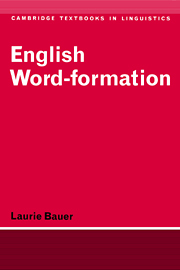Book contents
- Frontmatter
- Contents
- Dedication
- Preface
- 1 Introduction
- 2 Some basic concepts
- 3 Lexicalization
- 4 Productivity
- 5 Phonological issues in word-formation
- 6 Syntactic and semantic issues in word-formation
- 7 An outline of English word-formation
- 8 Theory and practice
- 9 Conclusion
- Bibliography and citation index
- Index
- Frontmatter
- Contents
- Dedication
- Preface
- 1 Introduction
- 2 Some basic concepts
- 3 Lexicalization
- 4 Productivity
- 5 Phonological issues in word-formation
- 6 Syntactic and semantic issues in word-formation
- 7 An outline of English word-formation
- 8 Theory and practice
- 9 Conclusion
- Bibliography and citation index
- Index
Summary
Morphology is inherently messy.
(Hooper, 1979: 113)Introduction
This chapter is mainly an introduction to some of the terminology required in the study of word-formation. Much of the terminology used is, in fact, common to all morphological study, and will help place word-formation in its broader framework. Thus the notion of inflection will not be dealt with at any length in the body of this work, but a definition of inflection is necessary in order to circumscribe derivation, for example. Since a mass of terminology is inevitably confusing, a flow-chart diagram is presented towards the end of the chapter which summarizes some of the main information (Figure 2.6, §2.15).
Although this chapter is, in some senses, the foundation stone upon which the rest of this work is built, the issues raised here are of interest in themselves, and in some cases provide problems for general linguistic theory. This is especially true, it seems to me, of the distinction between inflection and derivation, and of the postulated zero-morph in conversion.
Because most of this chapter is so introductory in nature and covers morphology as a whole and not just word-formation, readers with a solid background in linguistics may find it very elementary. Such readers are invited to pass swiftly over the bulk of this chapter, to §2.16, where points more specifically related to wordformation are dealt with.
Words and word-formation
Any discussion of word-formation makes two assumptions: that there are such things as words, and that at least some of them are formed.
- Type
- Chapter
- Information
- English Word-Formation , pp. 7 - 41Publisher: Cambridge University PressPrint publication year: 1983

